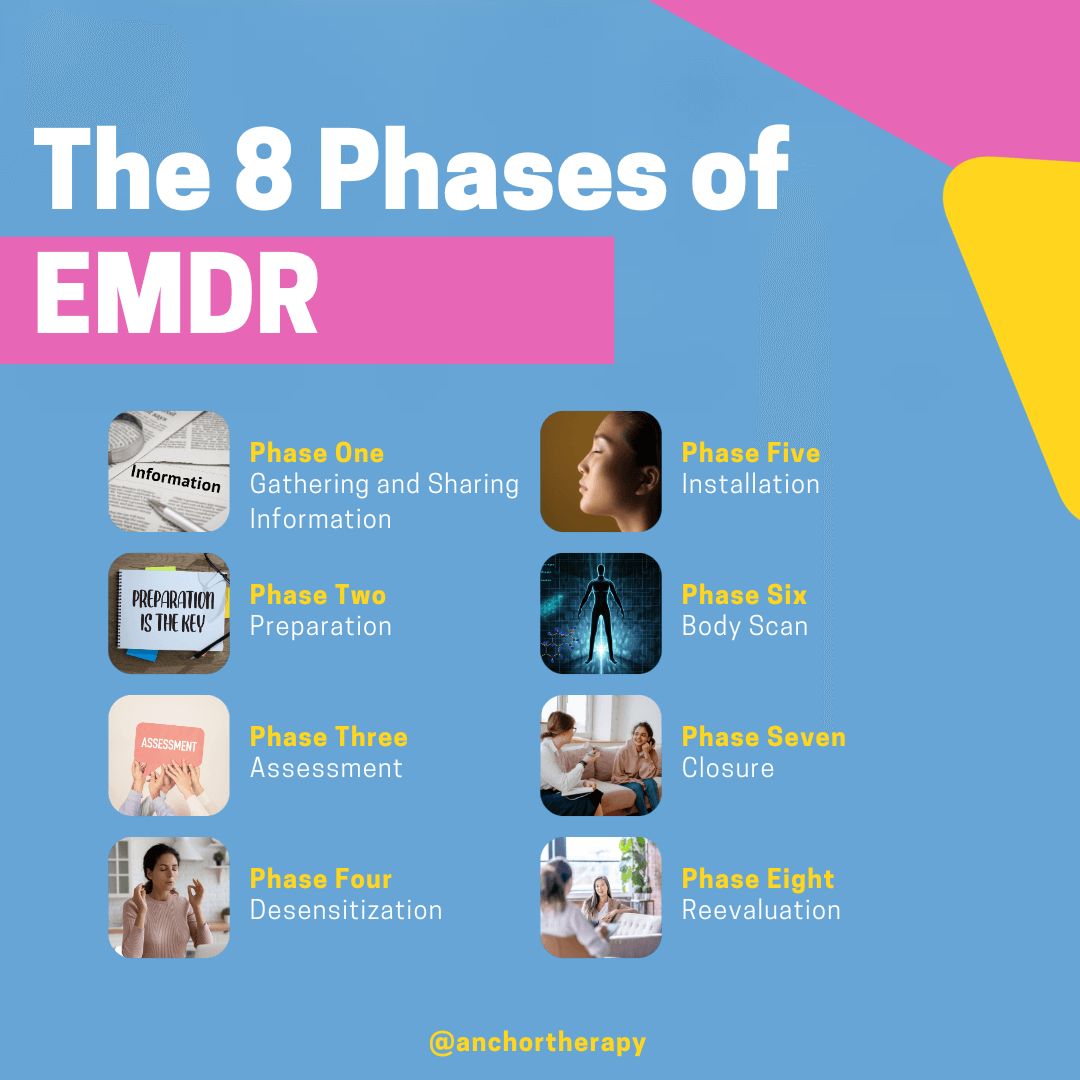Eye Movement Desensitization and Reprocessing (EMDR) Therapy
Eye Movement Desensitization and Reprocessing, often simply referred to as EMDR, is a psychotherapy treatment. EMDR treatment was originally created to help alleviate the stress connected to traumatic memories. EMDR therapy helps treat those with mental health conditions that happen due to a traumatic occurrence in your past. EMDR is specifically known for its position in treating Post-Traumatic Stress Disorder (PTSD). However, as the years have progressed, EMDR has expanded its usage to treat many other mental health conditions, such as depression and addiction and substance abuse issues.
What Is Rapid Eye Movement Therapy?
EMDR treatment near you is a mental health treatment type. Eye movement desensitization and reprocessing involves moving your eyes in a specific way while you recall traumatic memories. This psychotherapy technique was designed to relieve the distress you experience that is associated with disturbing memories. The goal of EMDR trauma therapy is to help you heal from trauma or other distressing life transitions or occurrences.
In eye movement therapy, you recall a troubling experience while following your EMDR therapist who presents a side-to-side visual stimulus. These lateral eye movements help lessen the emotional power of the disturbing memory. When this is done, the situation can be discussed in a safe environment, broken down, and you can free yourself of any anxiety triggers or avoidance regarding the given memory.
According to the American Psychological Association, eye movement desensitization was created in 1987. In 1989, the first clinical trial testing EMDR was conducted. For many years, clinical studies have shown the high level of effectiveness of eye movement desensitization and reprocessing and how much faster clients see results in EMDR treatment compared to other therapeutic interventions.
Who Can Benefit From EMDR Eye Movement?
EMDR can help people with a wide range of mental health conditions. EMDR is also suitable for people of all ages, from children and teenagers to adults and senior citizens. EMDR is particularly popular for the treatment of PTSD. PTSD is a psychiatric condition that is caused by people who have witnessed or experienced a traumatic event or series of traumatic events.
PTSD can occur after the following experiences:
Military combat
Physical assault
Rape
Car accidents
Natural disasters
Bullying
Historical trauma
Common symptoms of PTSD include:
Reliving aspects of what happened (e.g., vivid flashbacks)
Feeling on edge
Avoiding memories or feelings
Difficult feelings or beliefs
Intrusive thoughts or images
Nightmares
Physical sensations (e.g., sweating, nausea, trembling, etc)
Alongside PTSD, it is common to experience coexisting mental health disorders, like:
Anxiety disorders
Depression
Dissociative disorders
Self-harm
Suicidal thoughts (Feeling suicidal? Help is only a phone call away at the Free National Suicide Prevention Lifeline: 988)
Eye Movement Desensitization Reprocessing can treat the following mental health conditions:
Dissociative disorders
Eating disorders
Panic attacks
Phobias
Sexual dysfunction
The 8 Phases of Emdr Therapy
EMDR treatment can generally be split into eight phases.
The first three phases of eye motion therapy help pinpoint the problems that need to be addressed during your therapy sessions. During these stages, your eye movement desensitization and reprocessing therapist explains how the EMDR treatment process works.
The next three phases of the EMDR process are collectively known as “EMDR bilateral stimulation.” This is the active part of treatment. These steps make the connection between your emotional trauma, worrisome memories, your present state of mind, and the ways that your physical body responds to trauma therapy. The bilateral stimulation activates both sides of your brain with an EMDR therapist directing side-to-side eye movement so you can deal with your traumatic memories or difficult emotions in a different way. This process is referred to as “reprocessing.”
The final two phases of EMDR trauma treatment bring you to a calm, even-keeled state where you can access your trauma counseling.
In short, the emdr therapy stages can be broken down as follows:
Phase One: Gathering and Sharing Information
Phase one typically occurs during your first session with your therapist, known as the intake session. You and your EMDR licensed therapist will discuss your personal history as well as what made you come to therapy and your future therapeutic goals. During phase one, your EMDR counselor will come up with a treatment plan.
2. Phase Two: Preparation
In phase two, an EMDR practitioner will explain how EMDR works and how to properly manage any difficult emotions that may arise during the treatment.
3. Phase Three: Assessment
Phase three consists of you and your EMDR certified therapist recognizing traumatic events or circumstances you want to approach in mental health counseling sessions. You will discuss details of the given event or circumstance, the feelings you have associated with the event or circumstance, and how you would like to think or feel about it in the future.
4. Phase Four: Desensitization
During this phase, your main job is to focus on the target memory while your EMDR therapist guides you through the eye movements. If you are experiencing any new thoughts or feelings about your memory, you can share this with your mental health counselor.
5. Phase Five: Installation
Phase five is one of the highlights of EMDR therapy. It is where you begin to attach positive thoughts and emotions to a once-disturbing memory or a memory that has roots in trauma.
6. Phase Six: Body Scan
When you are thinking about a trauma-filled, disturbing memory, you want to pay attention to the physical sensations you are feeling. As EMDR therapy progresses, the goal is that you will experience fewer negative physical effects until you do not have any at all.
7. Phase Seven: Closure
Many EMDR treatments end with closure. Your EMDR clinician will help you reach a state of calmness where you feel comfortable and a sense of security. You and your EMDR specialist will discuss how you have processed your target memory and how you feel about your target memory at that point in your mental health treatment and healing journey. Your fully-licensed therapist will also provide you with tips on how to effectively manage any emotional challenges that you may experience in between your therapy sessions.
8. Phase Eight: Reevaluation
While this is the final phase, reevaluation is also done once the active part of therapy starts. During phase eight, you and your EMDR therapist will discuss how your sessions are going and discuss any new emotions, memories, or thoughts you are experiencing since the previous therapy session. During phase eight, you can make changes to your treatment plan if needed.
Since every client is different, there is no universal blueprint or timeline for EMDR treatment. Generally speaking, one traumatic memory or event may take anywhere from three to six sessions. If the event you are seeking therapy for is very complex or took place a long time ago, you can expect your total length in therapy to be longer. You may need eight to 12 sessions or more.
How Does EMDR Eye Movement Therapy Work Exactly?
EMDR is based on the Adaptive Information Processing (AIP) model. EMDR treatment directly impacts the way in which a distressing memory is stored in your brain. Past disturbing experiences can continue to wreak havoc on your mind and body when they are not adequately processed. When such memories are triggered in the present moment, they contain the exact same thoughts, feelings, and physical sensations that you experienced during the initial occurrence.
The eye movement that occurs in EMDR therapy imitates optic flow which calms down your body’s fear system. This temporarily lessens the sense of danger that traumatic memories capture.
The eyes are a part of your central nervous system, so the eyes can cue the brain to be in an alert or a relaxed state. In other words, they change your inner state.
Lateral eye movements suppress your amygdala, a main threat detection center in your brain. This regulation of amygdala activity activates a network in your brain that involves the cognitive regulation of your emotions.
What To Expect In EMDR Eye Movement Desensitization and Reprocessing Therapy at Anchor Therapy
At Anchor Therapy, we have EMDR therapists who have undergone extensive training to provide you with the best EMDR treatment experience possible. We offer in-person sessions at our downtown Hoboken, New Jersey office. We also conveniently have teletherapy services where we can offer virtual EMDR therapy. We offer EMDR therapy virtually to all residents of New Jersey, including Bergen County, Jersey City, and Montclair. We also offer EMDR online to all residents of New York and Florida.
In EMDR counseling, you can expect to attend anywhere from three to 12+ sessions to see results. Typically, clients will be seen once a week by their EMDR therapist; however, clients can also be seen two times a week.
After discussing your history and explaining the EMDR treatment technique, our EMDR counselor will help you decide which past experience(s) will be the focal point of your therapy sessions. Your therapist at Anchor Therapy will then stimulate the disturbing memory by asking you to visualize or experience the thoughts, emotions, or bodily sensations associated with the event.
Once the memory is activated, your EMDR therapist is constantly monitoring you and the level of negative feelings and thoughts you are experiencing in association to your target memory. Your EMDR specialist will also instill positive beliefs about yourself at the same time. After this, your EMDR counselor will start the bilateral visual stimulation.
When you are recalling distressing memories, it is normal to feel some level of emotional and/or physical discomfort. Any new feelings and thoughts you are experiencing are discussed with your mental health counselor. From there, your therapist gauges the level and nature of the cognitive and emotional distress you are experiencing.
When you feel calm is when the session ends. At Anchor Therapy, your EMDR counselor will never abruptly stop your EMDR session and expect you to carry on with your daily life and responsibilities. Anchor Therapy clinicians will also provide EMDR clients with instructions on how to manage disturbing thoughts and emotions that occur in between your eye movement desensitization therapy treatment sessions.
What Are The Advantages Of Attending EMDR Eye Movement Desensitization therapy Treatment near me?
There are many benefits to attending EMDR therapy.
Here are several benefits to attending EMDR therapy treatment:
It is effective. Dozens of studies have proven again and again that EMDR is an effective treatment for mental health disorders, especially for PTSD. An even greater benefit is that it tends to work faster than other forms of mental health counseling.
There is not much homework in EMDR. While each EMDR therapist is different, a client undergoing EMDR treatment can expect to not have much homework. In other forms of mental health therapy, clients have to complete journaling or other forms of homework outside of their sessions. In eye movement desensitization and reprocessing EMDR therapy, you typically only have to write down thoughts or ideas you want to mention at your next therapy session.
EMDR can be less stressful than other therapy treatment types. Eye movement desensitization therapy highlights overcoming your trauma by processing it.
EMDR has a low risk factor. The most common negative symptom that clients experience is negative thoughts or feelings between therapy sessions. Luckily, your Anchor Therapy EMDR clinician will help you understand what to expect in treatment and how you can react to this occurrence.
EMDR therapy is an effective method for those struggling with a traumatic memory along with other mental health conditions, like depression, OCD, and addiction and substance abuse problems.
Remember that EMDR is just one tool in your therapist’s world of knowledge. After assessing your condition at the intake session, your eye movement desensitization and reprocessing therapist will decide if other therapy techniques should be used, such as Cognitive Behavioral Therapy or CBT.
How Can I Start emdr Therapy at Anchor Therapy?
WORKING WITH anchor therapy IS EASY
Fill out the contact form below.
Once you fill out and send this Contact Form to us, one of our Intake Coordinators will receive your message. From there, one of our Intake Coordinators will respond to your inquiry, matching you with an EMDR therapist on our team who can effectively treat your trauma or other mental health condition(s).
Take pride in knowing that you are supporting your mental health through professional healing!



















